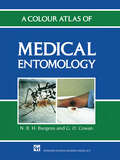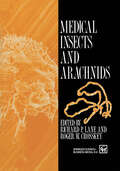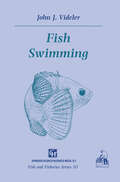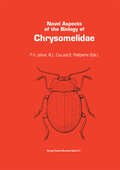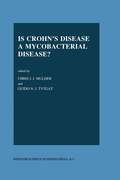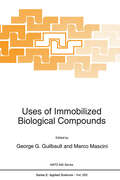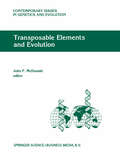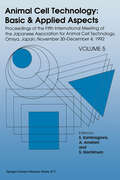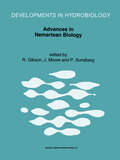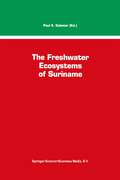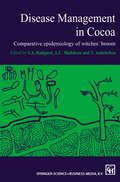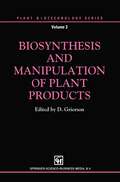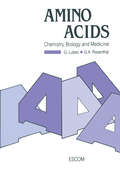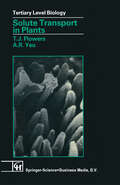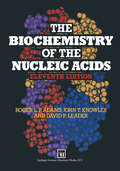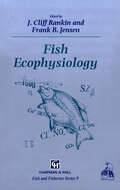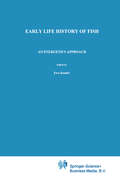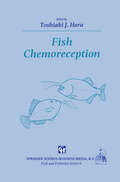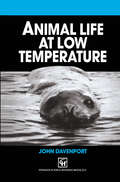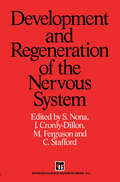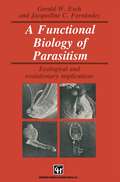- Table View
- List View
A Colour Atlas of Medical Entomology
by Nicholas Burgess G.O. CowanA there it is! guide to insects of medical and public health concern, mainly in the tropics. Each chapter covers identification, life cycle and habits of the causative stage and its medical/public health significance.
Medical Insects and Arachnids
by R.P. Lane R.W. CrosskeySurprising though it seems, the world faces almost as great a threat today from arthropod-borne diseases as it did in the heady days of the 1950s when global eradication of such diseases by eliminating their vectors with synthetic insecticides, particularly DDT, seemed a real possibility. Malaria, for example, still causes tremendous morbidity and mortality throughout the world, especially in Africa. Knowledge of the biology of insect and arachnid disease vectors is arguably more important now than it has ever been. Biological research directed at the development of better methods of control becomes even more important in the light of the partial failure of many control schemes that are based on insecticide- although not all is gloom, since basic biological studies have contributed enormously to the outstanding success of international control programmes such as the vast Onchocerciasis Control Programme in West Africa. It is a sine qua non for proper understanding of the epidemiology and successful vector control of any human disease transmitted by an arthropod that all concerned with the problem - medical entomologist, parasitologist, field technician - have a good basic understanding of the arthropod's biology. Knowledge will be needed not only of its direct relationship to any parasite or pathogen that it transmits but also of its structure, its life history and its behaviour - in short, its natural history. Above all, it will be necessary to be sure that it is correctly identified.
Resource Selection by Animals: Statistical design and analysis for field studies
by B.B. Manly L. McDonald D.L. ThomasWe have written this book as a guide to the design and analysis of field studies of resource selection, concentrating primarily on statistical aspects of the comparison of the use and availability of resources of different types. Our in tended audience is field ecologists in general and wildlife biologists in particular who are attempting to measure the extent to which real animal populations are selective in their choice of food and habitat. As such, we have made no attempt to address those aspects of theoretical ecology that are concerned with how animals might choose their resources if they acted in an optimal manner. The book is based on the concept of a resource selection function, where this is a function of characteristics measured on resource units such that its value for a unit is proportional to the probability of that unit being used. We argue that this concept leads to a unified theory for the analysis and interpretation of data on resource selection and can replace many ad hoc statistical methods that have been used in the past.
Fish Swimming
by J.J. VidelerAmong the fishes, a remarkably wide range of biological adaptations to diverse habitats has evolved. As well as living in the conventional habitats of lakes, ponds, rivers, rock pools and the open sea, fish have solved the problems of life in deserts, in the deep sea, in the cold antarctic, and in warm waters of high alkalinity or of low oxygen. Along with these adaptations, we find the most impressive specializations of morphology, physiology and behaviour. For example we can marvel at the high-speed swimming of the marlins, sailfish and warm-blooded tunas, air-breathing in catfish and lung fish, parental care in the mouth-brooding cichlids and viviparity in many sharks and toothcarps. Moreover, fish are of considerable importance to the survival of the human species in the form of nutritious, delicious and diverse food. Rational exploitation and management of our global stocks of fishes must rely upon a detailed and precise insight of their biology. The Chapman & Hall Fish and Fisheries Series aims to present timely volumes reviewing important aspects of fish biology. Most volumes will be of interest to research workers in biology, zoology, ecology and physiology but an additional aim is for the books to be accessible to a wide spectrum of non-specialist readers ranging from undergraduates and postgraduates to those with an intrerest in industrial and commercial aspects of fish and fisheries.
Rotifer Symposium VI: Proceedings of the Sixth International Rotifer Symposium, held in Banyoles, Spain, June 3–8, 1991 (Developments in Hydrobiology #83)
by John Gilbert E. Lubzens M. R. MiracleAs in previous symposia, some current research topics were selected for review and eight invited papers were presented. For the first time a paper was presented on the historical aspects of Rotiferology, covering European research between 1680-1950. A special workshop session was devoted to a debate on a controversial topic: Rotifer Phylogeny. The workshop resulted in a very successful discussion and the integration of scattered evidence and hypotheses on the phylogenetic origin of rotifers, the relationships between major rotifer groups, and the mechanisms of evolution.
Insect Immunity (Series Entomologica #48)
by J. P. N. PathakImmunity in insects is different from immunity in vertebrates. Insects lack immunoglobulins even though they are capable of reacting against foreign components with effective defense mechanism. There has been a marked advancement in most of the fields of science in the past two decades. Insect immunity is also one of them. It is a developing subject which is now established as a new branch in insect study. This treatise is an attempt to compile meaningful articles of leading workers in this field, nevertheless we do not claim that leadership in insect immunity is by any means restricted to them. The idea is to provide a vibrant description of various aspects of "Insect Immunity". With the rapid development of the subject, it is difficult for any one author to discuss all the aspects of an area in a limited number of pages, even then they have done their utmost to include the entire development of the subject in their articles. The treatise deals with insect haemocytes, their population, isolation and role in defense mechanism, humoral encapsulation, inducible humoral antibacterial immunity, cellular immune reactions, role of endocrines, role of prophenol oxidase system in cellular communication, haemagglutinins and impact of parasite on insect immune system. Some topics could not be covered because experts in those area though willing could not complete their commitment within time limits.
Novel aspects of the biology of Chrysomelidae (Series Entomologica #50)
by Pierre H. Jolivet M. L. Cox E. PetitpierreIs Crohn’s Disease a Mycobacterial Disease? (Developments in Gastroenterology #14)
by Guido N. J.Tytgat Chris J. J.MulderIS CROHN'S DISEASE A MYCOBACTERIAL DISEASE'! The fact that the differential diagnosis of inflammatory bowel disease includes intestinal infections has been a source of much interest and clinical concern for many years. Since the recognition of ulcerative colitis and Crohn's disease as clinical entities, numerous attempts have been made to identify a specific organism resulting in the clinical and pathologic picture of Inflammatory Bowel Disease. The first suggestion about a connection between Johne's disease, a chronic mycobacterial enteritis in cattle, and Crohn' s disease occurred in 1913, when Dalziel described enteritis in humans which, although resembling intestinal tuberculosis, he believed to be a new disorder. Since the work of Crohn in the thirties a few investigators attempted to look for mycobacteria in Crohn's disease. Until now the work of Van Patter, Burnham and others did not receive widespread recognition. In 1984 the isolation of M. paratuberculosis was reported by Chiodini et al. This report initiated the current interest and controversy about a mycobacterial etiology in Crohn's disease. The hypothesis "Crohn's disease is Johne's disease" did not receive widespread recognition, but has lead to the first muIticentered efforts to determine whether or not mycobacteria are associated with Crohn's disease.
Uses of Immobilized Biological Compounds (NATO Science Series E: #252)
by George G. Guilbault Marco MasciniIn Uses of Immobilized Biological Compounds the reader will find a comprehensive survey of the field written by acknowledged experts who met in Brixen, Italy, between May 9 and 14, 1993 for a NATO Advanced Research Workshop devoted to the topic. The resulting volume presents a critical review of the latest results in the area and sets guidelines for future research. The 53 reports presented here cover: (A) General Aspects of Immobilizing Biological Compounds; (B) Medical, Clinical and Pharmaceutical Applications; (C) Electrochemical Biosensors; (E) Defense Applications; (F) Immunosensors and Receptors; (G) Food, Environmental, Clinical and Analytical Applications; and (H) Biotechnology and Marketing. In short, all aspects of the area are presented, in a compact format which will appeal to undergraduates, technicians, and professional scientists in the food, clinical, environmental, pharmaceutical and industrial fields.
Transposable Elements and Evolution (Contemporary Issues in Genetics and Evolution #1)
by J. F. McDonaldIn the summer of 1992 a distinguished group of molecular, population and evolutionary geneticists assembled on the campus of the University of Georgia in Athens, USA to discuss the relevance of their research to the role played by transposable elements (TEs) in evolution. The meeting consisted of a series of informal discussions of issues brought up in papers written by the participants and distributed among them prior to the meeting. These papers and the transcripts of the ensuing discussions are presented in this volume.
Animal Cell Technology: Proceedings of the Fifth International Meeting of the Japanese Association for Animal Cell Technology, Omiya, Japan, November 30–December 4, 1992 (Animal Cell Technology: Basic & Applied Aspects #5)
by S. Kaminogawa A. Ametani S. HachimuraAnimal cell technology has been making tremendous progress. Originally this term reminded people of engineering for high density and large volume culture of animal cells. At present many fields of biological sciences are aiming at advance in animal cell technology. Cell culture engineering is aided not only with developments in apparatus, matrix, media, and computational analysis, but also with new biological procedures in gene and protein technology, cell biological resources and immunological methods. Results obtained with animal cell technology are applied to production of pharmaceuticals, diagnosis reagents and food endowed with physiological functions, and cell and gene therapy of animals and humans, and useful for elucidating scientific phenomena. It is also essential to establish methods of evaluation for functionality and safety of newly discovered molecules and cells. The progress in animal cell technology is supported by, and attributes in both of basic and applied sciences. The proceedings of the Fifth International Meeting of the Japanese Association for Animal Cell Technology (JAACT) covers the subjects above mentioned. The articles in this book will help researchers in many fields to understand the current status and future trends in animal cell technology. JAACT organized this Meeting and we express our gratitude to the members of JAACT. We gratefully acknowledge all the members of the organizing committee for their dedication in assuring the Meeting's success. For their valuable supports, we also thank the Japanese Biolndustry Association and Saitama Foundation for Culture and Industry.
Advances in Nemertean Biology: Proceedings of the Third International Meeting on Nemertean Biology, Y Coleg Normal, Bangor, North Wales, August 10–15, 1991 (Developments in Hydrobiology #89)
by R. Gibson J. Moore Per LundbergIn any scientific discipline, meetings with presented papers and discussions are the most effective stimulus to the advancement of knowledge. Nemerteans have long been largely neglected because their taxonomy is difficult: the need for histological study of serial sections has proved inhibiting to most zoologists. During the last twenty years, however, this intriguing phylum has attracted the attention both of increasing numbers of taxonomists as well as of workers interested in many aspects of, for example, their ecology, evolution, physiology and fine structure. The enthusiam stemming from the First International Meeting held in Philadelphia during December 1983 made it abudantly clear that regular meetings of this type should be continued. The Second, at the Tjärnö Marine Biological Laboratory in Sweden (August 1986), emphasized the importance of such international gatherings. The Third Meeting was held in Britain, at Y Coleg Normal, Bangor, North Wales, August 10--15, 1991, with 24 participants from six countries. This volume records most of the papers given at the conference.
The Freshwater Ecosystems of Suriname (Monographiae Biologicae #70)
by P. E. OuboterSince the limnological research on the man-made Brokopondo Reservoir in the 'sixties, numerous data have been collected on the ecology of Surinam rivers and swamps. This book is a compilation of these data: it is the first comprehensive survey of the aquatic ecology of one of the peripheral areas of Amazonia. The geomorphology of the country, situated on the Guyana Shield, is the main factor determining the limnological properties of rivers and creeks. This results in an overall picture that is quite different from Amazonia. The emphasis of The Ecosystems of Suriname is on the living aquatic resources, including aquatic and swamp vegetation, phyto and zooplankton, macroinvertebrates, fish, amphibians, reptiles and mammals. Although most of Suriname is still in a pristine state, the human impact on fresh waters is considerable in those areas of rapid economic development, emphasizing the necessity of conservation measures, specially tailored for aquatic ecosystems. The Ecosystems of Suriname is a valuable acquisition for all scientists, environmental managers and others interested in tropical aquatic ecology.
Molecular Chaperones
by R. J. Ellis R. A. Laskey G. H. LorimerCurrently one of the hottest topics in biochemistry, the concept of molecular chaperones has challenged the paradigm of protein self-assembly. Key figures in many disciplines review all aspects of molecular chaperones in this volume, which arises from a Royal Society discussion meeting. Overview chapters discuss the significance of chaperones in biochemistry, molecular genetics and cell biology. Each chapter is well referenced providing access to the literature.
Disease Management in Cocoa: Comparative epidemiology of witches’ broom
by Rudgard Maddison AndebrhanThe Monograph deals with the conception, planning, implementation, results and conclusions of the International Witches' Broom Project (IWBP), which was set up in 1985 with the aim of producing an economic management system for witches' broom disease of cocoa. The contributions of the various sponsors, and the roles played by the participating organizations and scientists are described in the introductory chapter. Chapter 2 provides a review of what was, and what was not known from published literature about the cocoa witches' broom pathosystem in 1989. The scope of the project and the approaches used are covered in Chapter 3, while Chapters 4 to 13 report on the field studies themselves in detail. The recent appearance of witches' broom in the important cocoa area of Bahia in Brazil is described in Chapter 14, before disease management recommendations are summarised and future prospects considered in the closing chapters. The many man-years of field research in the IWBP in a total of six countries generated much useful information which was analyzed both in the individual countries and collectively. Even with a document of this size, certain information and analyses with less direct relevance to disease management had to be omitted. It is expected that more detailed treatments of certain aspects will emerge in scientific papers, and further analyses will be undertaken.
Biosynthesis and Manipulation of Plant Products (Plant Biotechnology Series)
by Donald GriersonVolumes I and 2 of this Plant Biotechnology series reviewed fundamental aspects of plant molecular biology and discussed production and analysis of the first generation of transgenic plants of potential use in agriculture and horticulture. These included plants resistant to insects, viruses and herbicides, which were produced by adding genes from other organisms. Realisation of the potential of plant breeding has led to a resurgence of interest in methods of altering the structure, composition and function of plant constituents, which represents an even greater challenge and offers scope for improving the quality of a wide range of agricultural products. This, in tum, has resulted in a re-evaluation of priorities and targets by industry. Volume 3 of this series considers the biochemical and gentic basis of the biosynthesis of plant products such as starch, lipids, carotenoids and cell walls, and evaluates the ways in which biosynthesis of these products can be modified for use in the food industries. Authors also cover the biosynthesis of rare secondary products and the function and application of proteins for plant protection and therapeutic use. The emphasis throughout is on the relationship between fundamen tal aspects of biosynthesis and structure-function relationships, and application of this knowledge to the redesigning and altering of plant products by molecular genetics.
Amino Acids: Chemistry, Biology and Medicine
by G. Lubec Gerald A. RosenthalThere is little wonder in the fact that the investigation of amino acids is of fundamental interest to scientists from so many diversified fields. If amino acids were only basic constituents of enzymes as well as structural and other proteins, this property alone would elevate them to real scientific importance. Added to this role, however, is their ability to serve as building blocks for the production of many classes of secondary metabolites. They can support the biosynthesis of a myriad of natural products including nonprotein amino acids, cyanogenic glycosides, phar macologically active alkaloids, certain phenols, purines and pyrimidines, nucleic acids, condensed tannins, lignins and other metabolites. The approximately twenty or so amino (and imino) acids that comprise proteins are well known; less familiar are what is now approaching 600 nonprotein amino acids that have been isolated and characterized from plant, fungal or animal sources. Investigations of the protein amino acids have proven of outstanding value in enhancing our understanding of a variety of physiological and neurological topics that affect human health and well being. Amino acids are used to probe inhibitory and excitatory transmission receptors in the brain. They contribute to our understanding of epilepsy, development of anti-epileptic drugs, production of novel y-arninobutyric acid uptake inhibitors, and acute and chronic neurodegenera tive disorders.
Solute Transport in Plants (Tertiary Level Biology Ser.)
by T.J. Flowers A.R. YeoThe study of solute transport in plants dates back to the beginnings of experimental plant physiology, but has its origins in the much earlier interests of humankind in agriculture. Given this lineage, it is not surprising that there have been many books on the transport of solutes in plants; texts on the closely related subject of mineral nutrition also commonly address the topic of ion transport. Why another book? Well, physiologists continue to make new discoveries. Particularly pertinent is the characterisation of enzymes that are able to transport protons across membranes during the hydrolysis of energy-rich bonds. These enzymes, which include the H + -A TPases, are now known to be crucial for solute transport in plants and we have given them due emphasis. From an academic point of view, the transport systems in plants are now appreciated as worthy of study in their own right-not just as an extension of those systems already much more widely investigated in animals. From a wider perspective, understanding solute transport in plants is fundamental to understanding plants and the extent to which they can be manipulated for agricultural purposes. As physiologists interested in the mechanisms of transport, we first set out in this book to examine the solutes in plants and where are they located. Our next consideration was to provide the tools by which solute movement can be understood: a vital part of this was to describe membranes and those enzymes catalysing transport.
The Biochemistry of the Nucleic Acids
by R.L.P. Adams J.T. Knowler D.P. LeaderWhen the first edition of this book was published in 1950, it predated the publication of the double-helical structure of DNA by three years. It is not, therefore, surprizing that nothing of the original book remains in the current edition. Indeed, such is the pace of change in the field of nucleic acids that less than 50% of material incorporated into the 1986 edition has been retained. The book aims at the advanced undergraduate and at graduates that are undertaking course work or requiring an in-depth background for their research. It also aims to provide the established scientist with a single text that permits updating across the whole field from DNA structure, replication and repair, through gene expression and its control to protein synthesis. Every chapter is accompanied by thorough referencing that enables the reader to evaluate personally the data and methodology that cannot be included in the text. In an attempt to keep this list within bounds, references are limited to about ten per page and, to accommodate the more recent literature, many of the older references have been left out in this latest edition.
Fish Ecophysiology (Fish & Fisheries Series #9)
by J.C. Rankin Frank B. JensenAmong the fishes. a remarkably wide range of biological adaptations to diverse habitats has evolved. As well as living in the conventional habitats of lakes. ponds, rivers, rock pools and the open sea, fish have solved the problems of life in deserts. in the deep sea. in the cold antarctic. and in warm waters of high alkalinity or of low oxygen. Along with these adaptations, we find the most impressive specialisations of morphology, physiology and behaviour. For example we can marvel at the high-speed swimming of the marlins. sailfish and warm-blooded tunas, air-breathing in catfish and lungfish. parental care in the mouth-brooding cichlids and viviparity in many sharks and toothcarps. Moreover, fish are of considerable importance to the survival of the human species in the form of nutritious. delicious and diverse food. Rational exploi management of our global stocks of fishes must rely upon a detailed tation and and precise insight of their biology. The Chapman [.,. Hall Fish and Fisheries series aims to present timely volumes reviewing important aspects of fish biology. Most volumes will be of interest to research workers in biology. zoology. ecology and physiology but an additional aim is for the books to be accessible to a wide spectrum of non-specialist readers ranging from undergraduates and postgraduates to those with an interest in industrial and commercial aspects of IIsh and t1sheries.
Early Life History of Fish: An energetics approach (Fish & Fisheries Series #4)
by E. KamlerAmong the fishes, a remarkably wide range of biological adaptations to diverse habitats has evolved. As well as living in the conventional habitats of lakes, ponds, rivers, rock pools and the open sea, fish have solved the problems of life in deserts, in the deep sea, in the cold Antarctic, and in warm waters of high alkalinity or of low oxygen. Along with these adaptations, we find the most impressive specializations of morphology, physiology and behaviour. For example we can marvel at the high-speed swimming of the marlins, sailfish and warm-blooded tunas, air breathing in catfish and lungfish, parental care in the mouth-brooding cichlids and viviparity in many sharks and toothcarps. Moreover, fish are ofconsiderable importance to the survival ofthe human species in the form of nutritious and delicious food of numerous kinds. Rational exploitation and management of our global stocks of fishes must rely upon a detailed and precise insight of their biology. The Chapman and Hall Fish and Fisheries Series aims to present timely volumes reviewing important aspects of fish biology. Most volumes will be of interest to research workers in biology, zoology, ecology and physiology, but an additional aim is for the books to be accessible to a wide spectrum ofnon specialist readers ranging from undergraduates and postgraduates to those with an interest in industrial and commercial aspects of fish and fisheries.
Fish Chemoreception (Fish & Fisheries Series #6)
by T. J. HaraThis book describes in general how the chemosensory systems of fish function at various levels. In many ways, fish are typical vertebrates differing only slightly from other vertebrates including humans. In other ways, their aquatic environment imposes strict requirements or offers unique opportunities which have resulted in some unusual functions having no counterpart in higher vertebrates. This new volume is necessitated by advances in many vital areas as the field of chemical senses continues to grow at a rapid pace. Most significant is the application of the contemporary electrophysiological technique of patch-clamping, recognition of a second messenger system in chemosensory transduction processes and the identification of hormonal pheromones in fish reproductive behaviour. The last major synthesis of our knowledge about fish chemoreception, Chemoreception in Fishes, was published ten years ago (Elsevier, Amsterdam, 1982). In that volume four aspects of fish chemoreception, Le. morphology of the peripheral chemoreceptors. primary sensory processes, roles in behaviour, and its interactions with environment, were discussed. This book is intended to be helpful to students, scientists and aquacul turists not only as a source book but also as a textbook on chemical senses.
Animal Life at Low Temperature
by John DavenportTo humans, cold has a distinctly positive quality. 'Frostbite', 'a nip in the air', 'biting cold', all express the concept of cold as an entity which attacks the body, numbing and damaging it in the process. Probably the richness of descriptive English in this area stems from the early experiences of a group of essentially tropical apes, making their living on a cold and windswept island group half way between the Equator and the Arctic. During a scientific education we soon learn that there is no such thing as cold, only an absence of heat. Cold does not invade us; heat simply deserts. Later still we come to appreciate that temperature is a reflection of kinetic energy, and that the quantity of kinetic energy in a system is determined by the speed of molecular movement. Despite this realization, it is difficult to abandon the sensible prejudices of palaeolithic Homo sapiens shivering in his huts and caves. For example; appreciating that a polar bear is probably as comfortable when swimming from ice floe to ice floe as we are when swimming in the summer Mediterranean is not easy; understanding the thermal sensa tions of a 'cold-blooded' earthworm virtually impossible. We must always be wary of an anthropocentric attitude when considering the effects of cold on other species.
Development and Regeneration of the Nervous System
by S. Nona J. R. Cronly-Dillon M. J. W. Ferguson C. StaffordA Functional Biology of Parasitism: Ecological and evolutionary implications (Topics in Gastroenterology)
by Jacqueline C. Fernández Gerald W. EschSeries Editor: Peter Calow, Department of Zoology, University of Sheffield, England The main aim of this series will be to illustrate and to explain the way organisms 'make a living' in nature. At the heart of this - their functional biology - is the way organisms acquire and then make use of resources in metabolism, movement, growth, reproduction, and so on. These processes will form the fundamental framework of all the books in the series. Each book will concentrate on a particular taxon (species, family, class or even phylum) and will bring together information on the form, physiology, ecology and evolutionary biology of the group. The aim will be not only to describe how organisms work, but also to consider why they have come to work in that way. By concentration on taxa which are well known, it is hoped that the series will not only illustrate the success of selection, but also show the constraints imposed upon it by the physiological, morphological and developmental limitations of the groups. Another important feature of the series will be its organismic orientation. Each book will emphasize the importance of functional integration in the day to-day lives and the evolution of organisms. This is crucial since, though it may be true that organisms can be considered as collections of gene determined traits, they nevertheless interact with their environment as integrated wholes and it is in this context that individual traits have been subjected to natural selection and have evolved.
